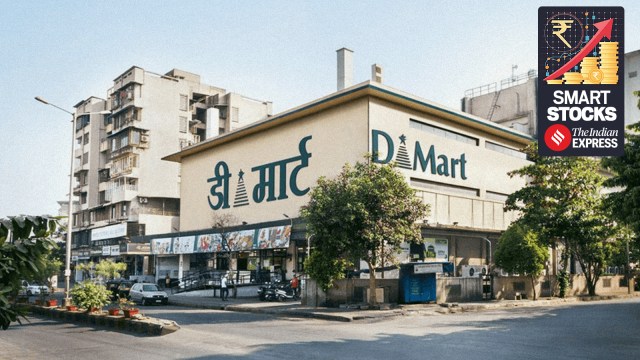Value vs convenience: Can DMart hold its ground against the quick commerce surge?
The rise of quick commerce is reshaping consumer behaviour, with many willing to pay for services like home delivery. DMart is facing challenges brought on by this shift. Will its focus on value endure the quick commerce wave, or is it on a secular decline? As competition rises, so do investor questions.
 Despite reporting a 32% growth in PAT in the last three years, DMart’s stock has delivered negligible returns since 2021.
Despite reporting a 32% growth in PAT in the last three years, DMart’s stock has delivered negligible returns since 2021.“The only thing better than free is convenience.” This sentiment resonates with those who believe quick commerce platforms will eat into DMart’s business.
At the centre of this debate — value versus convenience — is evolving consumer behaviour. More shoppers are now prioritising convenience, with many willing to pay for services like home delivery. DMart, traditionally positioned on the ‘value’ end of the spectrum, is facing challenges brought on by this shift.
Despite reporting a 32% growth in PAT in the last three years, DMart’s stock has delivered negligible returns since 2021. While it is partly due to high valuations, the growing competition from quick commerce players is becoming a major factor.
 Source: http://www.tradingview.com
Source: http://www.tradingview.com
The impact was evident in DMart’s Q2FY25 results, which led to a 35% stock correction within a month.
So, what’s going on? Is quick commerce just a passing trend, or could it permanently upend DMart’s business model? Let’s find out.
The rise of quick commerce
The quick commerce industry is expected to grow from approximately $3.34 billion in 2024 to nearly $9.95 billion by 2025, reflecting rising consumer demand and increasing market penetration. The sector is projected to achieve a 75% year-on-year (YoY) growth in 2025, driven by its expansion into new categories beyond groceries and its entry into Tier-2 cities.
This growth is attracting significant capital and is intensifying competition — not only between quick commerce players and traditional brick-and-mortar retail but also among the Q-commerce companies themselves, all of which remain loss-making.
While quick commerce has been a boon for customers, it remains to be seen if it will deliver returns for investors. For now, it seems that deep pockets are likely to help these companies continue the onslaught against traditional retail. Zepto has raised over $1.3 billion in the past year alone and is eyeing another $800 million to $1 billion through its IPO. And a significant portion of Swiggy’s IPO proceeds (around ₹11,000 crore) is likely to fund the expansion of Swiggy Instamart’s dark stores.
Hitting where it hurts
The rise of quick commerce is chipping away at DMart’s top-end, discerning customers. This shift has impacted DMart stores in metro cities with high throughput and where the Q-commerce juggernaut is currently focused.
As a result, the company’s high gross margin category — General Merchandise and Apparel (GMA) — has also seen its contribution to revenue drop. The contribution dropped from 28% in FY19 to 23.04% in FY23 and 22.37% in FY24.
 Source: Motilal Oswal Report
Source: Motilal Oswal Report
But competition isn’t the sole factor behind this decline. When a new DMart store opens, it initially attracts customers from a larger radius who buy more non-FMCG items. As the store matures, the customer base narrows to a smaller area, with purchases increasingly focused on food, FMCG, and grocery items.
However, the company has indicated that the declining contribution of the GMA category to sales is a secular trend that is expected to continue, which in turn is leading to contracting gross margin and EBITDA margin.
 Source: http://www.tijorifinance.com
Source: http://www.tijorifinance.com
The impact of these shifts is already starting to show in quarterly results. For example, in Q3FY25, while revenue grew a healthy 17.5% YoY, EBITDA margin growth was only 8.7%, and PAT margin grew by just 4.5%.
Additionally, competition in the Food and Grocery (F&G) segment, which constitutes the bulk of DMart’s sales, is increasing. During the Q2FY25 investor call, DMart management acknowledged that quick commerce could have a 1-1.5% impact on the same-store sales growth (SSSG) CAGR in cities with significant quick commerce activity.
DMart’s response
DMart has made a conscious decision not to pursue quick commerce. Instead, the company wants to focus on value, which means maintaining low prices, even for home delivery.
It is trying to achieve this through DMart Home, which is now attempting to pivot to ‘home delivery’’ instead of its earlier ‘pickup point’ model. It has shut down approximately 200 pickup locations and is reworking its operating model for DMart Ready. The company is also adding fulfillment centres, especially in the 25 major cities where it already operates.
DMart’s idea of ‘convenience’ is home delivery within 12 hours — rather than the 12-minute quick commerce race — and without resorting to a cash-burning approach. According to the company, approximately 40-45% of orders are delivered within 12 hours. Around 86% of orders are delivered within 24 hours. The remaining 14% of deliveries take more than 24 hours. This is usually because customers plan their delivery for a later date, using the preferred time slot option.
Unlike Q-commerce, DMart requires a minimum order value of ₹500 per order and currently offers free delivery. While it grew at 22% in 9MFY25, DMart remains loss-making, like most Q-commerce players. However, the losses are marginal and can be supported by DMart retail business without significantly impacting its profitability.
Growth vs Valuation
While the current impact of Q-commerce on DMart’s sales growth may not be significant, it remains to be seen how it evolves. This raises a pertinent question: Why should investors continue to pay 85 times earnings for DMart?
 Source: http://www.screener.in
Source: http://www.screener.in
The growth runway might be very long, and there is possibly no other player in the value retailing space that matches DMart’s quality.
Over the last three years, PAT has grown at 32% CAGR.
However, the Trailing Twelve Months (TTM) PAT growth was only 12%. This is primarily due to lower gross margins which dropped to 14.1% in Q2FY25 compared to 14.7% in H1FY25. Seasonality and inflationary pressures have also contributed to these results.
But there is no denying that Q-commerce is putting pressure on DMarts’ model and that it needs to adapt. Even a seemingly minor dent in gross margins has consequences. For example, a 0.5% contraction in TTM Sales equals ₹286 crore, or 10.5% of PAT. If the gross margin was higher by 0.5%, TTM PAT growth would rise to 18.5% versus the current 12%.
DMart’s ability to adapt to these challenges will be crucial in determining whether it can sustain its valuation multiples.
Is this another Amazon vs Walmart moment?
At the outset, the situation in the Indian retail market may look similar to the Amazon-Walmart rivalry in the US, where both players managed to co-exist successfully.
This comparison stems from the fact that, despite growing competitive intensity, DMart’s same-store sales growth was impacted by only 1–1.5% until recently. There is no denying that consumers value both affordability and convenience, and there’s no reason to believe that the two models can’t coexist. However, much will depend on how DMart navigates this challenge, especially in light of the recent departure of its long-time CEO Neville Noronha.
The DMart model, while still impressive, is getting tested.
Note: We have relied on data from http://www.Screener.in and http://www.tijorifinance.com throughout this article. Only in cases where the data was not available, have we used an alternate, but widely used and accepted source of information.
Rahul Rao has worked at an AIF, focusing on small and mid-cap opportunities and helped conduct financial literacy programmes for over 1,50,000 investors.
Disclosure: The writer and his dependents do not hold the stocks discussed in this article.
The website managers, its employee(s), and contributors/writers/authors of articles have or may have an outstanding buy or sell position or holding in the securities, options on securities or other related investments of issuers and/or companies discussed therein. The content of the articles and the interpretation of data are solely the personal views of the contributors/ writers/authors. Investors must make their own investment decisions based on their specific objectives, resources and only after consulting such independent advisors as may be necessary.



- 01
- 02
- 03
- 04
- 05




























